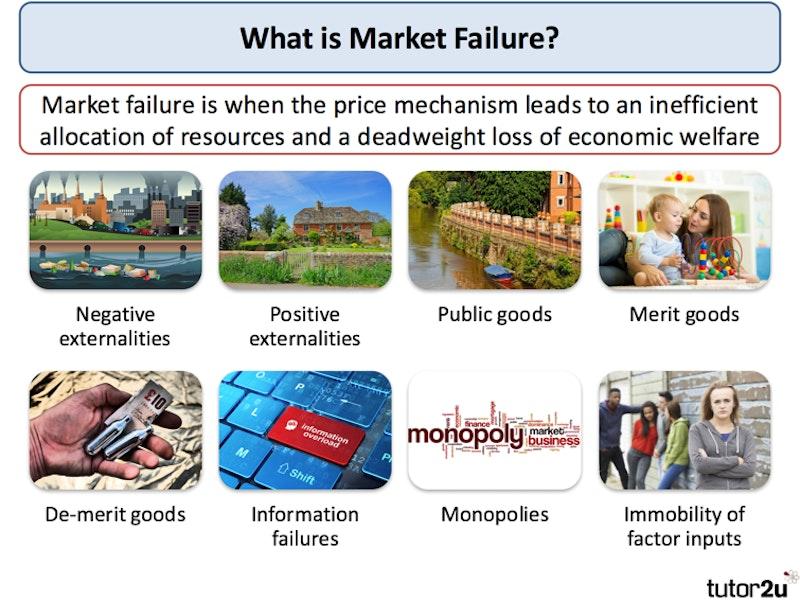What are five sources of market failure?
Market failure occurs when the allocation of goods and services by a free market is not efficient. There are several sources of market failure, and here are five key examples:
Externalities:
- Definition: Externalities occur when the production or consumption of a good or service affects third parties who are not directly involved in the transaction.
- Example: Pollution is a classic negative externality. When a factory emits pollutants, it may harm the health of nearby residents, and these costs are not reflected in the price of the goods produced by the factory.
Public Goods:
- Definition: Public goods have two key characteristics: non-excludability (individuals cannot be excluded from using the good) and non-rivalry (one person's use does not reduce its availability to others).
- Example: National defense is often cited as a public good. Once a country invests in national defense, it benefits all citizens, and it's challenging to exclude individuals from this benefit.
Imperfect Competition:
- Definition: Perfect competition is a theoretical market structure where there are many buyers and sellers, and no single entity can influence the market price. Imperfect competition occurs when this ideal condition is not met.
- Example: Monopolies or oligopolies (a market dominated by a small number of large sellers) can lead to reduced competition, limiting consumer choice and potentially resulting in higher prices.
Incomplete Information:
- Definition: Market transactions depend on the availability of accurate and complete information. Incomplete information occurs when buyers or sellers do not have access to all relevant information.
- Example: Asymmetric information, where one party has more information than the other, can lead to problems. For instance, if a seller knows more about the quality of a product than the buyer, the buyer may make suboptimal decisions.
Income Inequality:
- Definition: Market failure can occur when there is significant income inequality, leading to unequal access to goods and services.
- Example: In a society with extreme income inequality, certain individuals or groups may lack access to essential goods and services like education and healthcare, affecting overall social welfare.
Addressing market failures often requires government intervention, regulations, or other corrective measures to promote efficiency and fairness in resource allocation. It's important to note that the specific sources and implications of market failure can vary depending on the economic and social context.
Unraveling economic challenges: What are five sources of market failure?
Market failure occurs when markets fail to allocate resources efficiently, leading to a loss of economic and social welfare. There are five main sources of market failure:
- Externalities: Externalities are costs or benefits that are not reflected in the market price of a good or service. For example, a factory that pollutes the air imposes costs on society that are not borne by the factory itself. This is an example of a negative externality. A positive externality would be the benefits that society receives from education, which are not fully captured by the individual who receives the education.
- Public goods: Public goods are goods or services that are non-excludable and non-rivalrous. Non-excludable means that it is impossible to prevent people from consuming the good or service, even if they do not pay for it. Non-rivalrous means that one person's consumption of the good or service does not reduce the amount available for others to consume. For example, national defense is a public good because it is impossible to prevent people from benefiting from it, even if they do not pay taxes. It is also non-rivalrous because one person's consumption of national defense does not reduce the amount available for others to consume.
- Market power: Market power is the ability of a firm to influence the market price of a good or service. Firms can gain market power through mergers and acquisitions, monopolies, and cartels. When firms have market power, they can restrict output and raise prices above the competitive level, leading to a loss of consumer welfare.
- Incomplete information: Incomplete information occurs when buyers and sellers do not have all of the information they need to make informed decisions. For example, a buyer of a used car may not have all of the information about the car's condition, and a seller of a used car may not have all of the information about the buyer's creditworthiness. Incomplete information can lead to market failures such as adverse selection and moral hazard.
- Government failure: Government failure occurs when government policies do not achieve their intended goals or lead to unintended consequences. For example, a government policy that imposes a price ceiling on a good may lead to shortages and black markets. Or, a government policy that provides subsidies to farmers may lead to overproduction and waste.
Exploring common factors and causes contributing to market failures
The common factors and causes contributing to market failures include:
- Lack of competition: Competition is essential for efficient markets. When there is too little competition, firms may have market power and be able to restrict output and raise prices above the competitive level.
- Information failures: Buyers and sellers may not have all of the information they need to make informed decisions. This can lead to market failures such as adverse selection and moral hazard.
- Externalities: Externalities occur when the costs or benefits of a good or service are not reflected in the market price. This can lead to overproduction or underproduction of goods and services.
- Government failure: Government policies may not achieve their intended goals or lead to unintended consequences. This can also lead to market failures.
Insights into mitigating strategies and interventions for addressing market failures
There are a number of mitigating strategies and interventions that can be used to address market failures. These include:
- Government regulation: Governments can regulate markets to promote competition, reduce externalities, and protect consumers. For example, governments can set antitrust laws to prevent monopolies and cartels, and they can impose environmental regulations to reduce pollution.
- Public provision: Governments can provide public goods and services that are not provided by the market. For example, governments can provide national defense, education, and healthcare.
- Taxation and subsidies: Governments can use taxes and subsidies to correct for externalities and promote efficiency. For example, governments can tax pollution to reduce the negative externalities of pollution, and they can subsidize education to promote the positive externalities of education.
- Private solutions: Private firms can also develop solutions to market failures. For example, firms can develop insurance products to protect consumers from the risks of adverse selection and moral hazard.
The best approach to addressing market failures will vary depending on the specific market failure and the context in which it occurs. However, the mitigating strategies and interventions listed above can be effective in improving the efficiency and fairness of markets.











